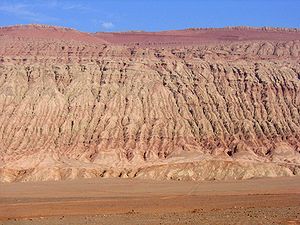Flaming Mountains
This article is written like a encyclopedic style or move the content to Wikivoyage . (February 2024) |

The Flaming Mountains (
The mountains are approximately 100 kilometres (60 mi) long and 5–10 km (3–6 mi) wide, crossing the Turpan Depression from east to west. The average height of the Flaming Mountains is 500 m (1,600 ft), with some peaks reaching over 800 m (2,600 ft). The mountain climate is harsh and the extremely high summer temperatures make this the hottest spot in China, frequently reaching 50 °C (122 °F) or higher. One of the largest thermometers in China is on display adjacent to the mountain, tracking the surrounding ground temperatures. It is a popular tourist spot.
A number of important palaeontological remains have been found in the area, see e.g. Lianmuqin Formation and Subashi Formation.
Silk route

In ancient times, the merchant traders traversing the
The
Literary fame
The Flaming Mountains received their name from a fantasy account of a
Mythology
According to the classical novel
The Princess Iron Fan possessed the magical Iron Fan, and used it to remove the fire on the Flaming Mountains, though since she only fanned once each time, it would only able to be removed for a year, before the fire started again. The pilgrims encounter an extremely hostile range of volcanic mountains and can only pass if the volcanoes become inactive. Her fan, made from banana leaves, is extremely large and has magical properties, as it can create giant whirlwinds. Using this advantage, she made the residents near there revere her as their goddess, and they would have to give her some food if they want her to solve their problem about the Flaming Mountains.[7]
In a Uighur legend, a dragon lived in the Tianshan Mountains. Because the dragon ate little children, a Uighur hero slew the dragon and cut it into eight pieces. The dragon's blood turned into a scarlet mountain of blood and the eight pieces became the eight valleys in the Flaming Mountains.[8]
Climate
An unconfirmed soil surface temperature of 66.8 °C (152.2 °F) was estimated by satellite measurement in 2008.[9]
Footnotes
- ISBN 0-8021-3797-0.
- ISBN 0-521-43519-6.
- ^ "Bizaklik Thousand Buddha Caves". showcaves.com. Retrieved 2007-09-19.
- ^ "Bizaklik Thousand Buddha Caves". travelchinaguide. Retrieved 2007-09-19.
- ISBN 0-521-43519-6.
- ^ "The Third Cross-Strait Conference — Post-conference Tour to the Flaming Mountains". University of Massachusetts.edu. Archived from the original on 2007-02-20. Retrieved 2007-09-18.
- ISBN 978-0-7735-3197-0.
- ^ "The Flaming Mountains (Huo Yan Shan)". travelchinaguide.com. Retrieved 2007-09-21.
- .
